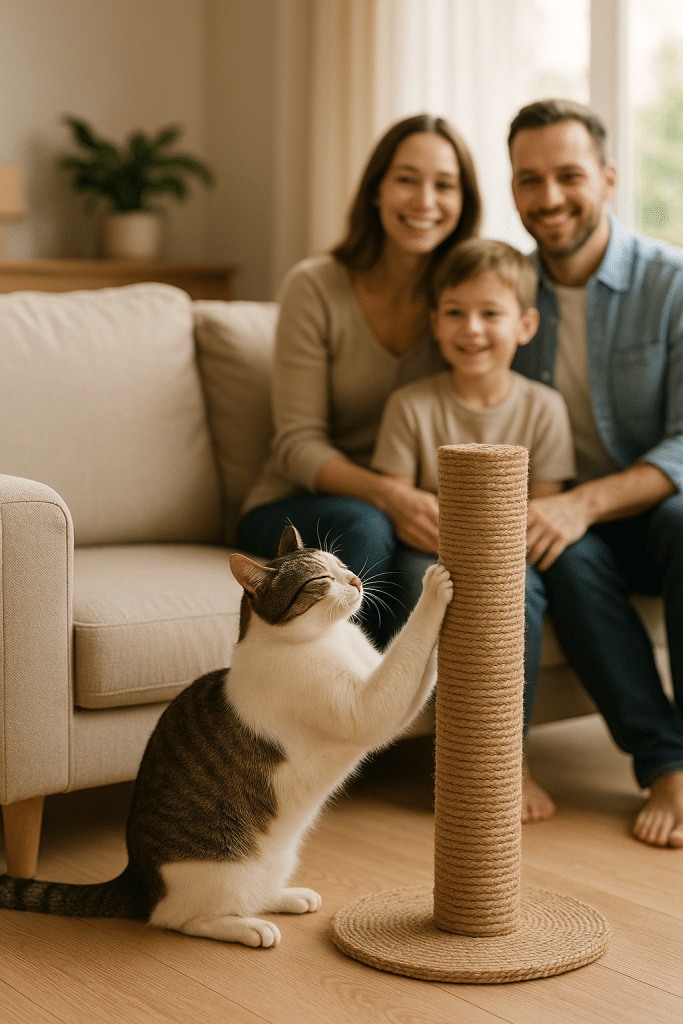If you’re a pet owner or part of a family with feline friends, chances are you’ve faced the frustration of discovering your prized sofa or favorite armchair bearing the marks of your cat’s scratching habits. How to stop cat scratching furniture is a question many of us have pondered, especially when we want to protect our belongings without punishing our furry companions. Cats scratch for a variety of natural, instinctual reasons—from claw maintenance to marking territory to stretching their muscles. And while scratching is perfectly normal, it’s up to us as responsible pet owners to channel this behavior in ways that safeguard both the cat’s needs and our home environment.
In this comprehensive guide, I’ll dive into why cats scratch furniture, how to identify the problem areas, and most importantly, practical and effective strategies to redirect your cat’s scratching in positive directions. I’ll also explain how to choose the right scratching posts, apply safe deterrents, use nail trimming and nail caps, provide enriching environments, and care for kittens who need early training. Along the way, I’ll incorporate long-tail, expert-backed advice on gentle, natural, and affordable solutions to tackle cat scratching furniture without punishment. Whether you’re dealing with a rambunctious kitten or a grown cat who’s set in their ways, this article will equip you with everything you need to maintain harmony between your cat’s instinctual behaviors and your furniture’s longevity.
Understanding Why Cats Scratch Furniture
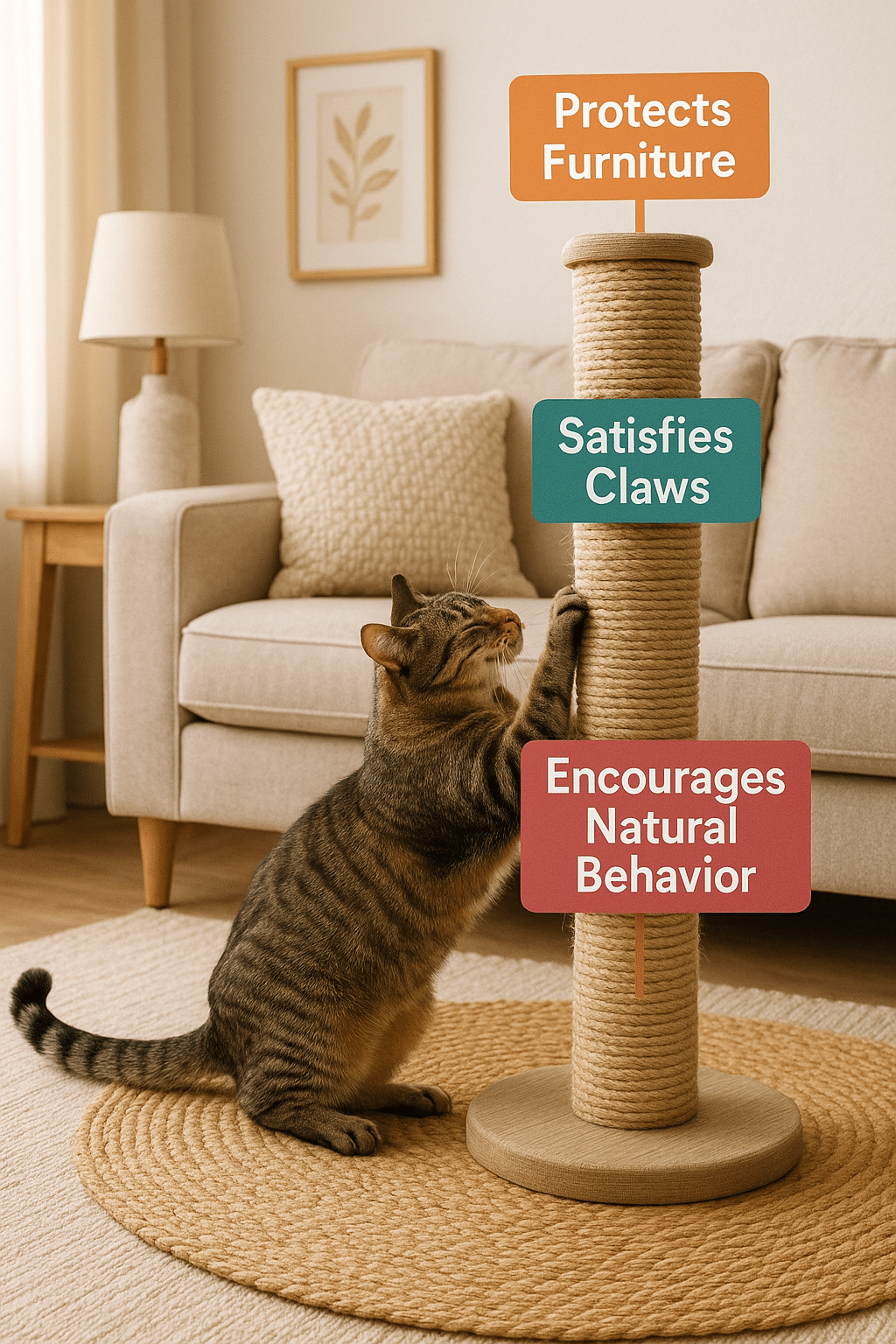
Before jumping into prevention, understanding the why behind your cat’s scratch-happy behavior is essential. Scratching serves several key biological and emotional functions for cats.
Claw Maintenance and Feline Anatomy
Cats’ claws are living structures analogous to our fingernails that grow continuously. Scratching is a natural way for cats to:
- Shed the outer layer of dead claw sheaths, helping to keep their claws sharp and healthy.
- Stretch their toes, muscles, and tendons in the paws and forelimbs.
When cats scratch furniture, it’s often about claw maintenance. Scratching fabrics or wood peels off the claw’s dead outer layers, much like humans filing their nails. Cats do this instinctively daily.
Territorial Marking and Social Behavior in Cats
Scratching is also a means of territorial marking. Cats have scent glands in their paws, so scratching leaves both:
- A visual mark (scratches) and
- A chemical signal (pheromones).
This helps cats mark their territory and communicate messages to other cats about their presence. In multi-cat households or areas where outdoor cats roam, scratching furniture can be a way your cat is staking claim.
Stretching, Exercise, and Emotional Well-being
Scratching serves a physical and emotional purpose:
- It’s a stretching exercise, keeping muscles limber and in shape.
- It can be a stress-relieving behavior, especially if the cat experiences anxiety or boredom.
Understanding these motivations helps prevent frustration when trying to stop scratching. We want to redirect the behavior, not punish it, because scratching is a genuine feline need.
Identifying High-Risk Furniture and Scratching Patterns
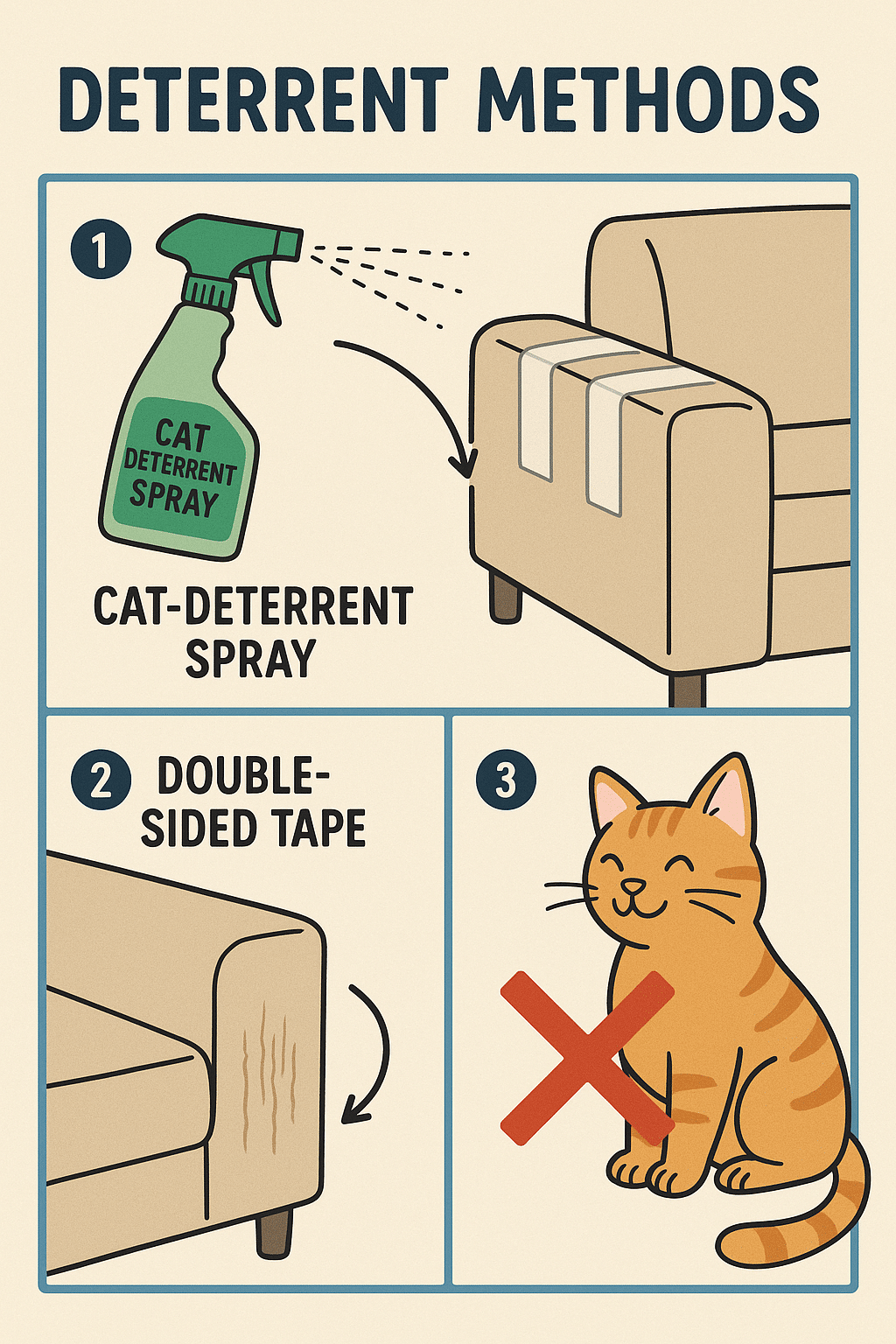
Knowing exactly where and why your cat scratches lets you plan targeted interventions.
Common Furniture Targets and Popular Scratching Spots
Cats gravitate toward certain types of furniture often:
- Sofas and couches: Especially ones with fabric upholstery like microfiber or velvet. The soft texture is inviting.
- Armchairs and recliners: Cats like scratching vertical surfaces.
- Wooden furniture legs and sides: The texture offers a different scratching resistance.
- Carpeting and rugs on furniture pieces: An easy target to sink claws into.
- Leather furniture can also be tempting since natural leather can feel satisfying for scratching, though it’s more prone to visible damage.
Take note where your cat scratches most; scratching often occurs near their favorite lounging spots or areas they perceive as “territory.”
Breed-Specific Tendencies and Behavioral Differences
Certain cat breeds are more predisposed to scratching furniture:
- Siamese and Oriental breeds are known for high energy and frequent scratching.
- Maine Coons and Bengals have larger claws and more strength, often leading to more noticeable damage.
- Domestic shorthairs generally vary, but behavior depends more on individual temperament.
Knowing your cat’s breed tendencies can prepare you for possibly more intense scratching and help tailor your strategy.
Providing Appropriate Scratching Outlets to Redirect Behavior
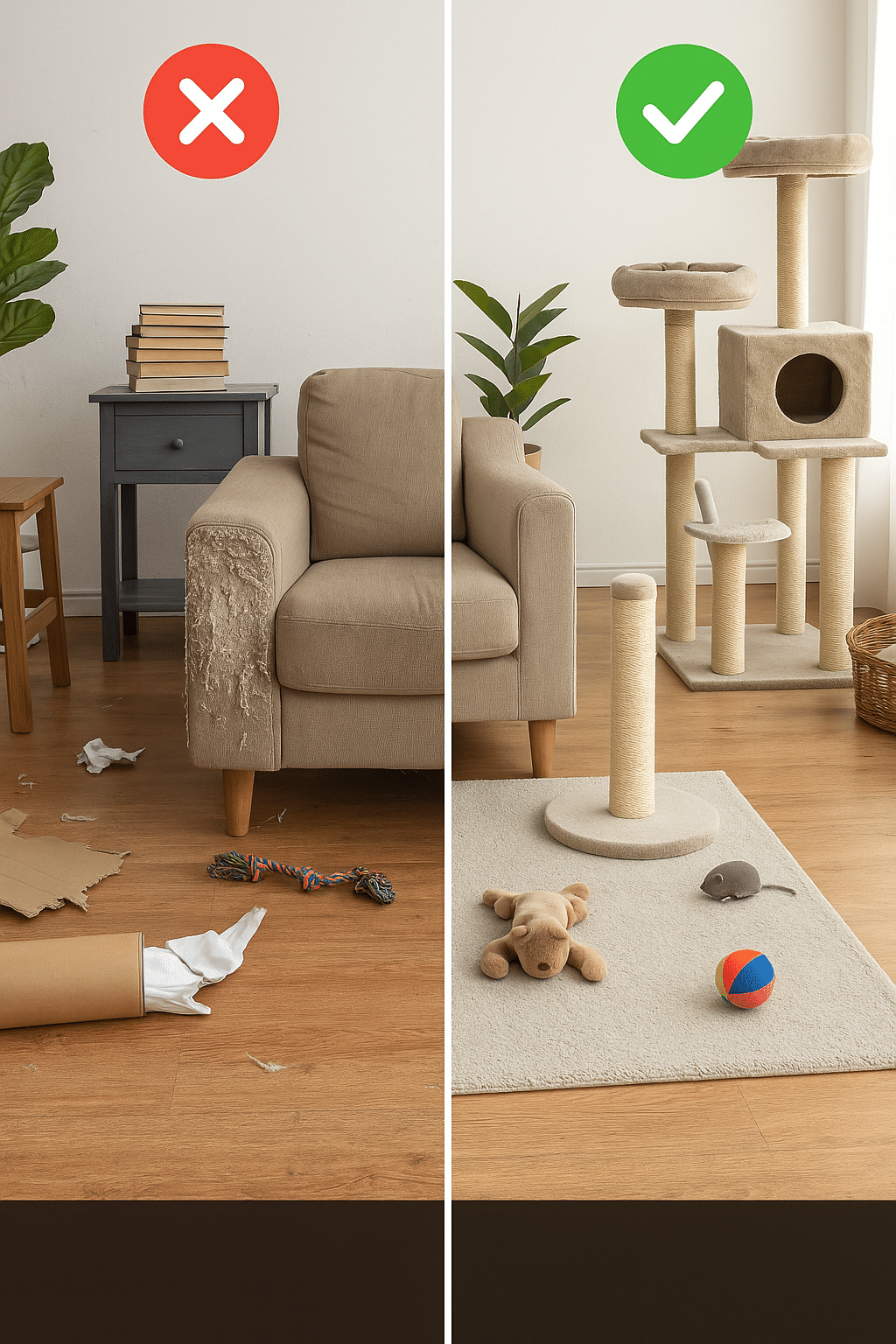
The cornerstone of how to stop cat scratching furniture lies in offering cats acceptable alternatives to satisfy their scratching instincts.
Choosing the Right Scratching Posts and Pads
Cats need scratching surfaces that feel right to their paws. Look for:
- Height: Posts should be tall enough for your cat to stretch fully, usually 28 inches or taller for average-sized cats.
- Stability: Avoid wobbly or flimsy posts — unstable ones deter use.
- Varied Textures: Cat’s preferences vary — some love rough sisal rope, others prefer carpet or corrugated cardboard.
Materials to Consider: Sisal, Carpet, Cardboard and More
- Sisal: This natural fiber is durable and rough, closely mimicking tree bark, a favorite texture for many cats.
- Carpet: Some cats favor carpet but test carefully, as many cats have negative associations if the carpet smells like other animals or people.
- Cardboard: Corrugated cardboard scratchers appeal to cats who love shredding textures and can be inexpensive and disposable.
- Wood or carpet wrapped posts: May also be used but often less popular.
Placement Strategies Based on Cat Preferences and Patterns
Placement is just as important as the post itself. Place scratching posts:
- Near furniture your cat already targets.
- In commonly frequented areas, like living rooms.
- Near sleeping or resting spots—to allow stretching as soon as your cat wakes up.
- Multiple posts in different rooms may help if your cat roams widely.
Encouraging Use: Positive Reinforcement and Reward Systems
To encourage adoption of scratching posts, use:
- Catnip sprays or dried catnip to attract cats to the posts.
- Toys dangling from the top encourage play behavior near the post.
- Treats and praise immediately when the cat uses the post.
- Never punish your cat for scratching furniture; instead, redirect gently.
- Reward consistency is key for behavioral change.
Applying Safe and Effective Deterrents for Furniture Protection
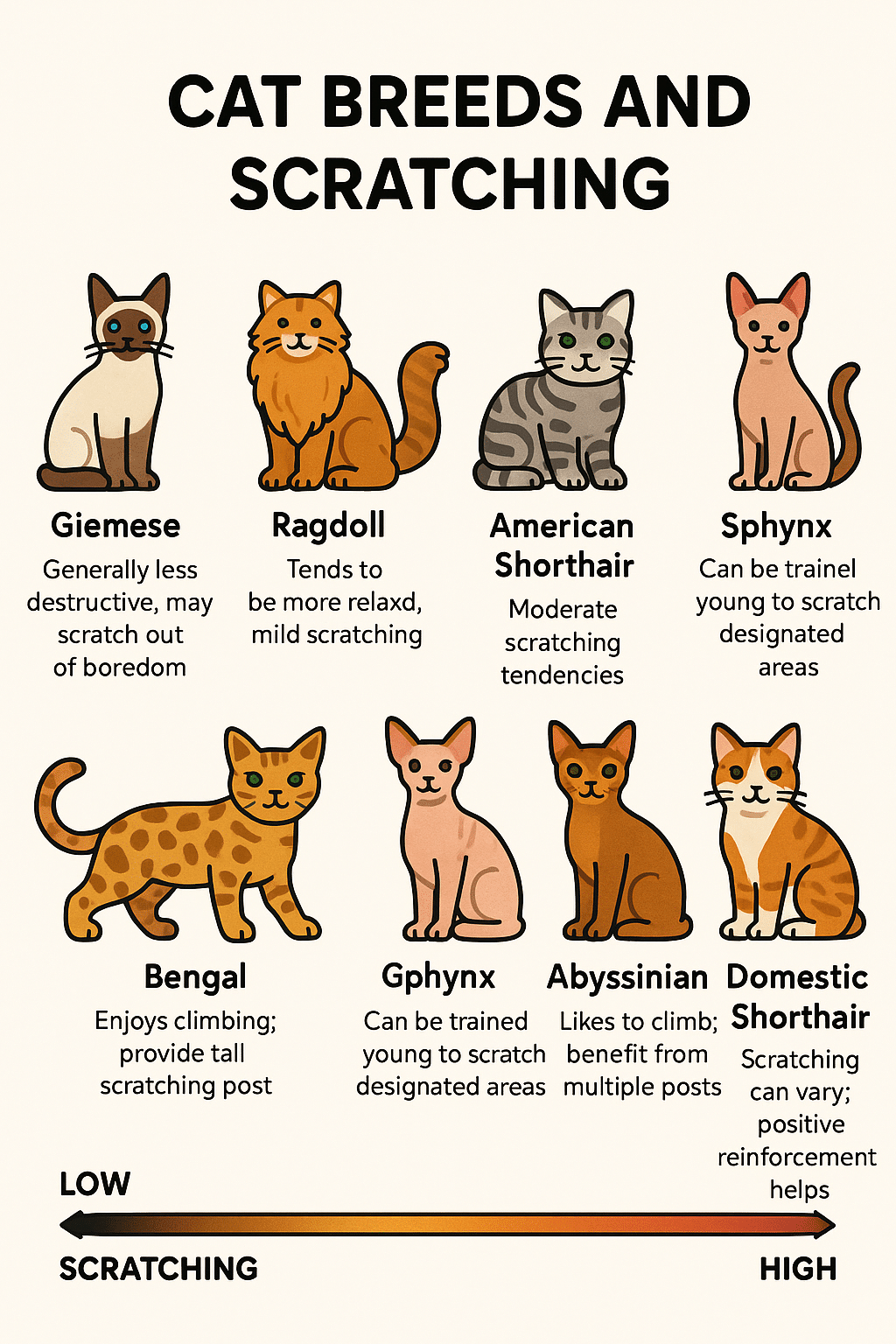
If your cat continues targeting furniture despite alternatives, consider adding safe deterrents to protect your belongings.
Physical Deterrents: Double-Sided Tape, Aluminum Foil, and Protective Covers
- Double-sided sticky tape (such as “Sticky Paws”) applied to furniture edges deters scratching because cats dislike the sticky sensation under their paws.
- Aluminum foil placed temporarily can repel cats due to its sound and texture.
- Plastic furniture covers or slipcovers can reduce claw damage and make furniture less appealing.
Popular, affordable cat furniture protectors like Sticky Paws Cat Tape have great user reviews for reducing furniture scratching.
Sensory Deterrents: Natural Sprays, Citrus Scents, and Textural Repellents
- Cats tend to dislike citrus scents. Using pet-safe sprays with orange or lemon oils can discourage scratching.
- Commercial cat repellent sprays made with safe plant-based ingredients avoid stress and harm.
- Some cats avoid rough textures placed strategically near furniture, such as plastic mats or rubberized barriers.
Reviewing Affordable Cat Furniture Protection Products
Affordable products include:
- Sticky Paws Tape (priced around $10–15 per roll).
- Furniture protectors with vinyl sleeves to cover chair legs and sofas.
- Cat scratch deterrent mats and pads that can be placed discreetly.
These products are widely available online and in pet stores and can complement other behavioral training.
Nail Maintenance and Alternatives to Reduce Furniture Damage
Proper nail care is an essential, practical step in reducing furniture damage.
How to Trim Cat Nails to Prevent Scratching Damage
Regular nail trims limit the sharpness of claws:
- Use cat-specific nail clippers for safety.
- Restrain your cat gently with a towel if needed.
- Only trim the sharp, translucent tip, avoiding the quick (pink area with blood vessels).
- Trim every 1–2 weeks to maintain dull nails.
If you’re unsure, watch instructional videos from veterinarians or ask your vet for a demo.
Using Soft Nail Caps: Application, Safety, and Benefits
Soft nail caps like Soft Paws® are small vinyl covers glued over claws:
- Safe, humane, and non-toxic.
- Usually last 4–6 weeks until the claw sheds naturally.
- Great for cats that refuse trimming or when scratching damage is severe.
Application requires patience, and most pets tolerate them well without discomfort.
When to Seek Professional Grooming Help for Nail Care
If your cat is difficult to handle or you’re anxious about trimming nails:
- Professional groomers or your vet can provide regular nail trims.
- They can also apply nail caps professionally.
- In some cases, behavioral therapists can advise on claw-related problem behaviors.
Enhancing Feline Environmental Enrichment to Reduce Destructive Scratching
A bored or stressed cat is more likely to scratch inappropriately. Enrichment helps reduce this.
Providing Interactive Toys and Climbing Structures for Physical and Mental Stimulation
- Interactive toys like feather wands, laser pointers, and puzzle feeders keep cats engaged and expend energy.
- Cat trees and climbing shelves provide vertical space for stretching and scratching.
- Switch up toys regularly to maintain interest.
- A well-stimulated cat has less inclination to damage items out of boredom.
Stress Reduction Techniques to Mitigate Scratching Due to Anxiety
Cats scratch more when anxious. Consider:
- Feliway® diffusers or sprays to release calming pheromones.
- Routine and predictability; avoid sudden environment changes.
- Adequate hiding places in the home so your cat feels safe and secure.
These strategies help address emotional causes of scratching.
Addressing Kittens and Training Young Cats Early
Training young cats sets the foundation for good behavior as adults.
Age-Appropriate Training Methods for Kittens
- Start offering scratching posts as early as 8 weeks old.
- Encourage kitten to scratch posts—use catnip and toys.
- Use gentle redirections to the post if they begin clawing furniture.
- Avoid punishment; instead, praise and reward appropriate scratching.
Training kittens early ensures scratching furniture becomes less of a problem as they mature.
Natural Remedies and Gentle Techniques to Redirect Behavior Without Punishment
- Use natural deterrent sprays made of diluted citrus or herbal blends safely around furniture.
- Distract with toys immediately when kitten approaches furniture.
- Consistently redirect scratching attempts with patience and calm voices.
Cleaning and Scent Management to Prevent Repeated Scratching
Removing scents signals territory can prevent repeat scratching.
Effective Use of Enzymatic Cleaners to Remove Territorial Marks
- Cats are drawn to scents where they’ve scratched before.
- Use enzymatic cleaners (like Nature’s Miracle) to break down pheromones.
- Regular cleaning discourages repeated markings on the same spot.
Maintaining Furniture Cleanliness to Dissuade Cats
Vacuum and clean areas regularly to remove dust and scents, and keep the furniture looking less inviting to cats.
When to Consult a Veterinarian or Animal Behaviorist
Sometimes scratching reflects deeper medical or psychological issues.
Identifying Medical or Behavioral Issues Behind Excessive Scratching
- Excessive scratching may indicate skin infections, allergies, or parasites.
- Behavioral causes include stress, anxiety, or compulsive disorders.
- Consult your vet for a thorough exam if scratching escalates or includes biting/licking.
Professional Behavioral Modification Strategies and Possible Treatments
- Certified animal behaviorists can design customized behavior modification plans.
- In some cases, medication may help reduce anxiety-driven scratching.
- Early intervention yields best results.
Repairing Furniture Damage and Long-Term Protection Strategies
Even with prevention, some damage may occur. Here’s how to repair and protect.
DIY and Professional Repair Tips for Scratched Furniture
- Use wood fillers, wax sticks, or furniture markers to camouflage scratches on wooden surfaces.
- For upholstery, patch kits or professional reupholstering may be needed.
- Leather furniture can sometimes be restored with leather repair kits.
Investing in Durable and Scratch-Resistant Furniture Materials
- Consider materials like microfiber, synthetic leather, or heavy-duty treated fabrics that resist claws better.
- Slipcovers and washable throws also protect underlying fabric.
Q1: How to stop cat scratching furniture without punishment?
A1: Focus on providing enticing scratching posts, use positive reinforcement like treats, and gently redirect your cat when they target furniture. Avoid yelling or physical punishment as it can increase stress and worsen behavior.
Q2: What are the best ways to redirect cat scratching from furniture to posts?
A2: Place posts near favorite furniture spots, use catnip and toys on the posts, reward use with treats, and make sure posts are stable and the right texture. Consistency is key.
Q3: Are there natural remedies to prevent cats from scratching furniture?
A3: Yes, citrus-based sprays, herbal deterrents, and pheromone diffusers are natural options that cats dislike and help keep furniture safe without harm.
Q4: How to trim cat nails to prevent furniture scratching?
A4: Use proper clippers and trim only the sharp tips weekly. Make sure not to cut into the quick (pink part). If unsure, seek help from a vet or groomer.
Q5: What affordable cat furniture protectors are available?
A5: Double-sided sticky tape like Sticky Paws, plastic furniture guards, and aluminum foil are inexpensive, effective, and easy to apply on high-risk furniture areas.
- Cats scratch for claw maintenance, stretching, and marking territory.
- Understanding your cat’s scratching motives helps redirect behavior effectively.
- Choose and position the right scratching posts to meet your cat’s preferences.
- Safe deterrents like double-sided tape and citrus sprays protect furniture with no harm.
- Regular nail trims and soft nail caps reduce damage significantly.
- Environmental enrichment and stress reduction lower destructive scratching.
- Consistent, gentle training of kittens prevents future furniture damage.
- Clean furniture with enzymatic cleaners to remove scent markers.
- Consult professionals if scratching is excessive or medical issues are suspected.
- Repair minor damage with DIY kits or invest in scratch-resistant furniture.
Conclusion
Knowing how to stop cat scratching furniture effectively is a blend of understanding feline instincts, providing the right alternatives, and protecting your home in a humane and constructive way. As a cat owner myself, I’ve learned that patience and positive reinforcement go a long way to keeping both your cat and your furniture happy. By offering appropriate scratching posts, trimming nails, applying safe deterrents, and enriching your cat’s environment, you create a balanced space where your pet can express natural behaviors without the frustration of ruined furniture. Remember, punishing your own cat only breeds fear and mistrust, while gentle training nurtures a strong bond.
If you’re struggling right now, take heart—there’s an abundance of affordable products like Sticky Paws and soft nail caps, alongside natural remedies that can help. Don’t hesitate to reach out to your veterinarian or a behavioral expert if needed. Together, you can protect your treasured furniture while giving your cat the comfortable, stimulating home they deserve. So, why wait? Start implementing these strategies today and watch your cat’s scratching become a manageable, even enjoyable, part of living together.
Happy cat parenting!

